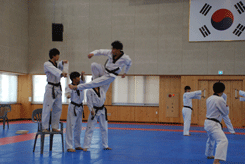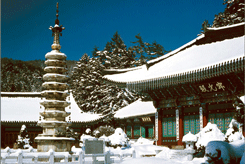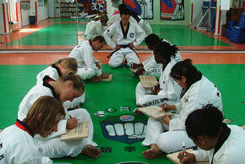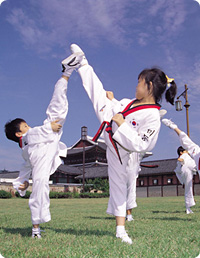Taekwondo
 |
 |
 |
Translated literally, "Tae" means to jump, to fly and to kick or smash with the foot. "Kwon" denotes the fist-chiefly to punch or destroy with the hand or fist. "Do" means an art or way - the right way built and paved by the saints and sages in the past.
First developed in Korea, Taekwondo is a Korean traditional martial art and a kind of sports and exercise that mainly uses hands and feet. It helps people keep their physical and spiritual health through studying the skills of defense and offense. It also provides body flexibility and skills to control strength, balance, breath, eyes and finally concentration of the spirit, as well as mental discipline to cultivate the spirit of martial art. Taekwondo has been in existence for thousands of years and has been practiced at the ancient ceremonies and rituals. Taekwondo has been developed from Taekkyeon, which was widely practiced amongst the court armies in Goguryeo and Silla. Taekwondo weathered a difficult time during the Japanese colonial rules, and it once was named Karate. But, Korean masters continued to spread it.
In 1961, Korean Taekwondo Association was first established after which the Taekwondo was officially accepted as a sport, and in 1963 as a medal sports in the national athletic meeting. Kukkiwon, the headquarters of Korean Taekwondo, was formed in 1972 and began to set up the Taekwondo rules. It has 8 weights, fin being the lowest followed by fly, bantam, feather, light, welter, middle and heavy. It also has different grades for the skills level of players which are identified by the colors of the belt. There are individual and team competition. Individual competition is conducted by having two contestants, Cheong (blue) and Hong (red), play on a 8m x 8m contest area. Kicks are allowed only when attacking the face. Hits below the lower abdomen are forbidden. All vulnerable parts of body are covered with protectors. One match consists of three three-minute rounds each with one-minute recess in between. One referee and four judges manage the match and points are considered valid when two or more judges recognize them.
One effective attack obtains one point. Two warnings or one point losing penalty on prohibited acts are subject to a deduction of one point. The winner is determined by knockout or higher points scored, and in case of a tie by superiority in the judge's decision which is to be based on the attack initiatives demonstrated during the contest. Although Taekwondo is very much about kicking, punching, self-defense, board-defense, board breaking and competition, it transcends beyond physical boundaries. Taekwondo is a sport that anyone can pick up at any time without the need to have special tools. It is a discipline of mind and body, a modern world sport, and a philosophy. Today, there are more than 4,000 Dojang, a Taekwondo school, with 25,000 masters and some 3 million students in Korea. It is practiced worldwide among all ages and is accepted now as an official medal event starting from the Sydney Olympics back in 2000. Today well over 4000 masters are actively teaching Taekwondo outside Korea.
Taekwondo Tenets
Taekwon-Do students should attempt to practice the following elements of courtesy to build up their noble character and to conduct the training in an orderly manner.
1) To promote the spirit of mutual concessions
2) To be ashamed of one's vices, contempt of others
3) To be polite to one another
4) To respect justice and humanity
5) To distinguish instructor from student, senior from junior, and elder from younger
6) To behave oneself out of courtesy and respect
7) To respect others' possessions
8) To handle matters with fairness and sincerity
9) To refrain from giving or accepting gifts when in doubt
Taekwondo Philosophy
1. Be willing to go where the going may be tough and do the things that are worth doing even if they are difficult.
2. Be gentle to the weak and tough to the strong.
3. Be content with what you have in money and position but never in skills.
4. Always finish what you begin, be it large or small.
5. Be a willing teacher to anyone regardless of religion, race or ideology.
6. Never yield to repression or threat in the pursuit of a noble cause.
7. Teach attitude and skills with action rather than words.
8. Always be yourself even if your circumstance changes.
9. Be the eternal teacher who teaches with the body when young, with words when old, and by moral precept even after death
Taekwondo weight table
|
Taekwondo term
Junbi
It is the readiness of moving body. From Jnnbi, you should be prepared to move in any direction with any technique, according to the command.
It is a bowing. Bowing is a traditional way of showing respect. It is imperative that we bow with sincerity. Be sure to bow slowly taking about 4 seconds, bending at the waist and looking down not looking at the person you bow to. You show respect and trust.
Pumse
Poomae is the very basic form of Taewondo. Pumse is performed by following the lines of movement in a systematic and consecutive way against an imaginary opponent or multiple number of opponents by using various Taekwondo techniques. Pumse helps us to apply the techniques of hand and foot and the changes of stance learned from the basic techniques to an actual fighting scenario. Each Taekwondo 'Pumse' comprises various stances that are each unique but well blends into one another. A 'Pumse' consists of about two dozen stances interconnected. Blocking, punching, striking, thrusting and kicking are integral part of Taekwondo Pumse. As these movements are properly carried out with hands, fists and feet to attack the vital spots of the opponent's body, one shifts stances accordingly moving from the forward stance, back stance, cat stance to the horse-back riding stance, etc. as the situation requires. Most typical 'Pumse's are Palgwe one through eight, Taeguk one through eight, Goryeo, Geumgang, Taebaek, Pyeongwon, Sipjin, Jitae, Chunkwon, Hansu and Ilyeo.
Taegeuk
This represents the most profound oriental philosophy from which philosophical views on the world, cosmos and life are derived. The vital points of this Pumse are to match the speed of breath with actions, and to shift the body weight properly while executing actions in an agile manner.
Palgwe
Supplementary Training. This uses the concept of the ancient Oriental Philosophy, which symbolically implies all the phenomena of man and the universe.
Goryeo : Goryeo Pumse is based on the spirit of the literati inherited down to Goryeo kingdom. Songae means strong martial art and spiritual integrity of the scholars.
Geumgang
The word "Geumgang" originally means being too strong to be broken. Also in Buddhism, what can break off every agony of mind with a combination of wisdom and virtue is called "Geumgang".
Taebeck
Pumse "Taebaek" takes its principles of movement from the word "Taebaek" which means being looked up to as sacred.
Pyeongwon
"Pyeongwon" basically means the 'vast plain'. The plain is a source of sustaining human life. At the same time, one cannot but feel the nature's majesty when a great open plain stretches out endlessly before one's eyes. Pumse Pyeongwon applies providence of the plain, which is blessed with abundance, grace and boundless vastness into the practice of Taekwondo.
Sipjin
Sipjin has the meaning of the 'decimal system', which stands for a symbolical figure of 10 meaning endless development and growth in a systematic order. In Pumse Sipjin, stability is sought in every change of movements.
Jitae
The earth is indeed the origin and terminal of life. Pumse "Jitae" is characterized by the features of all living things as well as all the natural phenomena of the Earth.
Chunkwon
Chunkwon" signifies the sky. From ancient times the Orientals have always believed and worshipped the sky as ruler of the universe and human beings. The infinitely vast sky will always be a mysterious and profound world of imagination to the eyes of the finite human beings. Pumse Chunkwon is composed of the motions which are full of piety and vitality.
Hansu
Pumse "Hansu" is derived from the word 'water'. It is characterized by its fluidity and adaptability as manifested in the nature of water.
Ilyeo
"Ilyeo" signifies oneness. The ultimate ideal of Taekwondo lies in this state of Ilyeo. The final goal Taekwondo pursues is indeed a discipline through which we can concentrate attention on every movement, and shake off all worldly thoughts.
Gyeorugi
Gyeorugi is Sparring. Gyeorugi is generally the focal point of competition. Taekwondo sparring is fast-paced and vigorous. Free sparring is one of the best ways for students to test their techniques and combinations. You need endurance, speed, balance, agility, focus, timing, and strategy. Sparring competition is usually categorized according to sex, age, weight, and rank.
Gyeokpa
Board breaking. The purpose of Gyeokpah in Taekwondo is to test the students' focus and power and to help the students overcome their fear of striking the board. Gyeokpa is not just an impressive demonstration of skills, but can help develop confidence.
Chagi
Chagi means kick. Kicks are used in Taekwondo both for self-defense and competition. Taekwondo enthusiasts are known for their versatile and powerful kicking techniques. No other martial art places as much emphasis on kicking as Taekwondo does. Chagi also refers to the striking surfaces of the foot used to hit a vital area.
Chigi
Strikes and punches. Strikes and punches are quicker than kicks. They also allow for more stability. Chi-gi also refers to the striking surfaces of the arm and hand that are used to hit a vital area.
Dorra
Turning around. A command to reverse your direction. This command is usually given at the end of a set of stepping movements so that the students can turn and resume their steps in the opposite direction.






